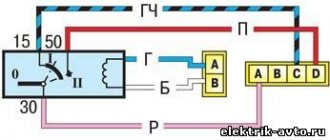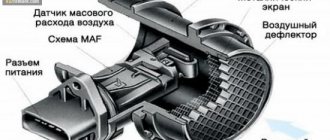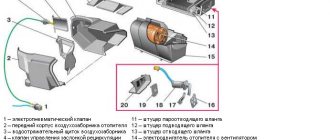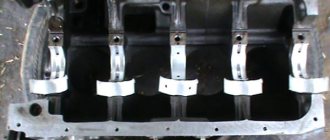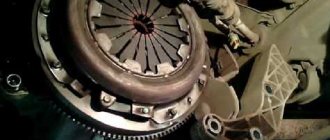History of the VAZ 2103 1.5
In the early 70s, in the Soviet Union there was a need for a more powerful engine for domestic Zhiguli cars than the existing VAZ 2101 model. To obtain an engine with more power, it was decided to modify the already proven engine of the 01 model. Changing the height of the cylinders by almost 9 millimeters made it possible to increase the power and volume of the cylinders by 300 cubic centimeters.
In all other respects, this is the same VAZ 2101, which in turn is a modified copy of the FIAT 124, released in 1968. Model 01 engine is not an exact copy; Russian engineers changed the timing belt design. On an Italian car, the camshaft was located in the cylinder block, and the BC head was cast iron. It contained a jacket for coolant and holes intended for installing spark plugs.
On the 03 model, the BC head is made of aluminum alloy. It has supports in which the camshaft is installed; 8 valves are placed on it, 2 per cylinder.
This is how the legendary VAZ 2103 engine appeared in 1972. During production, this engine was supplemented several times. So, in 1974, the carburetor design was revised, two years later a fuel mixture quality screw was added, and in 1980, an “Ozone” carburetor began to be installed on the 03 engine. In 1977, the engine wiring underwent large-scale changes, the connectors and terminal design were changed. Even when the VAZ 2106 engine appeared, model 03, for several more years, was more popular and in greater demand than the six.
Motor VAZ 2111
As mentioned above, the VAZ 2111 engine is the beginning of the era of distributed fuel injection. The appearance of cars of the “tenth family” allowed engineers to work in a qualitatively new direction, and in general, it was successful, completely changing the standard operating parameters of VAZ injection engines.
Motor 2111, like its successors 2112, 21114, 21124, 21118, are installed on car models 2108, 2109, 21099, 2110, 2111, 2112, 2114, 2115 in their various modifications, as well as on Lada Kalina. Many owners of old carburetor cars, without betraying their favorites, simply install a new injection unit in their cars, thereby extending their life by more than a dozen years.
What changed:
- Over a fifteen-year period, these units changed their volume from 1500 cm3 to 1800, and their power increased by 20 hp. With. And if the 2111 engine is a kind of modification of the 21083 and 2110, distinguished by additional mounting holes for the generator, an ignition module and a knock sensor, then, for example, the VAZ 21124 engine is a fundamentally different unit. Chip tuning of the VAZ engine originates from it.
- The only controversial point in the particularity of these VAZ engines is the increase in the number of valves from 8 to 16. And if you are wondering on which engines the valves bend when the timing belt breaks, then you need to remember only one modification of the engine: 2112, despite the fact that it one of the most common VAZ engines for tuning.
- In addition, the VAZ 2112 engine has completely different characteristics among VAZ engines and other typical operating parameters of VAZ injection engines. Unlike 2111, the power here has been increased to 93 hp. With. (2111 – 78), torque 127/3700 (115/3000), with a reduced volume from 1600 to 1500 cm3.
- Another camshaft appears here, as well as a different air supply system to the cylinders. This engine, naturally, has become more powerful, but the driver would rather prefer a calmer and more economical driving style due to the torque at low speeds.
- The difference between the later 21114 and 21124 is that the height of the cylinder block was increased by 2 mm, and the crankshaft stroke increased from 71 to 75.5. These technical characteristics determined the addition of volume to the VAZ engine up to 1600 cm3.
- Plus, the fuel system with the injector ramp has been slightly modified, the fuel return line has been eliminated, and a catalytic converter has been installed.
- The fundamentally new ignition system is now a four-terminal coil, and not an ignition module, as on the 2111. The quality of this ignition is certainly better, but some problems may appear during the plant in winter, but this is only out of habit.
Most often, when choosing a car, taking into account the technical characteristics, owners try to avoid this unit, but this is done only by those who are not very meticulous about caring for the engine, since troubles can be avoided by timely replacement of the belt, and the purchase of this part should be treated more responsibly .
When choosing a belt, you can only trust a trusted manufacturer, information about which can be found on the Internet or from friends, since you cannot trust salespeople in stores 100%. Frequent counterfeits of well-known companies cannot be ruled out, which leads to underestimation of a particular belt. Accordingly, at least within the time specified by the standard characteristics, the belt simply must be checked by the owner.
Technical data VAZ 2103
- Manufacturer: AvtoVAZ, Togliatti.
- VAZ 2103 is a four-stroke, gasoline, carburetor engine, the four cylinders of which are placed in 1 row.
- The cylinder block is made of cast iron. Engine weight 03 model 121 kg.
- The gas distribution system is an overhead camshaft and has 8 valves.
- The VAZ 2103 lubrication system is combined, splashing, as well as pressure.
- Power supply system - carburetor, carburetor type 1107010-20.
- The ignition system of the VAZ 2103 is contact or can be non-contact type, has one common coil for 4 cylinders. The cylinders operate in the order 1-3-4-2.
- The exact volume of the VAZ 03 engine is 1452 cubic centimeters. VAZ 2103 engine power at 5600 rpm min., 71 l., force. Torque of VAZ 2103 at 3400 rpm, 104 Nm.
- The pistons are aluminum and have a tin coating. Their stroke length is 80 mm. The diameter is 76 millimeters. Compression ratio VAZ 2103 - 8.5
Fuel consumption
Fuel consumption when driving around the city is 9.4 liters, per 100 km, mileage. When driving on the highway 6.9 liters. Total consumption is 8.9 liters per 100 km. The fuel used is AI 93.
Oil consumption
The permissible consumption of motor lubricant is 700 grams per 1000 km, mileage. The types of oil used are 5W40, 15W40, 5W30, 10W40. The lubricant volume in the engine is 3.75 liters. When filling in new oil, you need to take 3.5 liters. Engine lubricant must be replaced every 10,000 kilometers.
Resource
The service life of the VAZ 2103 engine declared by the manufacturer is 125 km. With proper maintenance and careful driving, the engine life can exceed 200,000 kilometers.
Operation of the treshka engine
In general, engine operation does not cause any particular problems. Timely completion of routine maintenance, oil changes, adjustment of the VAZ 2103 carburetor, and the use of high-quality motor fuel ensure a long period of engine operation. The operation of the engine also has its own specifics that must be taken into account.
One of the specific features of the 2103 engine is that the timing chain drive does not have a chain tensioner. This leads to the need for periodic inspection, and in some cases, restoration of normal operation is required. The regulatory frequency of such an audit is 10,000 km. With some experience, you can make this adjustment yourself. Here is a step-by-step action plan:
- completely unscrew the tensioner cap nut;
- using your finger to control the position of the tensioner rod, turn the crankshaft 1-1.5 turns in the direction of its rotation;
- as soon as the tensioner rod is sunk, the spring will automatically adjust the chain tension through the shoe;
- tighten the cap nut.
Another important regulatory procedure when operating a VAZ 2103 engine is adjusting the thermal valve clearances. The need to repair the valve arises when there is a distinct knocking sound in the engine at low speeds. Adjustment is carried out in the following order:
- Align the marks on the gear and camshaft housing.
- Use a wide feeler gauge of 0.15 mm to adjust the 8th and 6th valves.
- Rotate the crankshaft 180 degrees and adjust valves 4 and 7.
- Rotate the crankshaft another 180 degrees to align valves 1 and 3.
- Rotate the crankshaft 180 degrees again to adjust valves 5 and 2.
You can turn the crankshaft by rolling the car forward in fourth gear.
Features of the BC VAZ 2103
The BC of the engine 03 of the Zhiguli model is cast from especially durable cast iron. Inside there are main oil channels and jackets for coolant circulation. At the bottom of the crankshaft there are five supports for installing the crankshaft. The support covers are not interchangeable and should not be interchanged.
BC 03 differs from BC VAZ 2101 in its greater height distance. This is necessary to obtain an engine volume of 1.5 liters. The BC was manufactured taking into account a center-to-center distance of 95 millimeters. The cylinders have between-repair sizes. The diameter of the cylinder sizes has five classes. They are designated by Latin characters in alphabetical order from A to E. The difference between the classes in size is 0.01 mm. At the bottom of the BC, near the center of all cylinders, their class is indicated. Taking into account all possible cylinder repairs, the engine service life is about 800 thousand kilometers.
Some people like it hot
Young owners of VAZ “classics” sometimes tune their vehicles. Of course, a new body kit, straight-through exhaust or deafening music is not always enough. Therefore, they resort to modernizing the power unit.
The easiest way to tune the 2105 engine is to install the next generation DAAZ 21053 Solex carburetor. The increase, of course, will be insignificant.
A higher increase in power is provided by boring the cylinders and increasing the piston stroke. Possible options:
- Boring the cylinder bores to 82 mm increases the volume to 1400 cm³.
- Using the same pistons, but a longer crank (shaft 2103 with an 80 mm crank) and connecting rods shortened by 7 mm gives 1600 cubes.
- When both options are combined, the working volume becomes 1700 cm³. This tuning of the VAZ 2105 engine allows you to achieve a power of 100 hp. With.
A more radical way to improve technical characteristics is to replace the standard engine with a rotary power unit (VAZ 413 Wankel engine), produced at VAZ in small batches. Despite its small size, the tuning drive produces 140 horsepower. Of course, getting it is very problematic.
The engine with the VAZ 2105 index was underestimated because it was ahead of its time. It became the first domestic engine with a timing belt instead of a traditional chain. Time has shown the viability of this solution. On modern cars (especially small and middle class) belts are more common than chains. To a large extent, this was facilitated by the increase in the service life of these products.
Design features of cylinder head 03 model
The BC head is common to four cylinders. The height of the cylinder head is 112.5 millimeters, the volume of the combustion chamber is 33.2 cubic meters, cm. Its size is 51 × 79 millimeters. Inside the combustion chamber there is a milled step with a height of 2 mm.
A camshaft is installed inside the cylinder head on supports. It houses 8 valves, 4 intake and 4 exhaust valves. One intake and one exhaust valve per cylinder. The shaft has one distinctive feature: between the fists of the 2nd cylinder there is a raw neck in the shape of a regular hexagon. The timing drive is a double-row roller chain consisting of 116 links, which requires periodic tensioning. There are no hydraulic compensators, so timely adjustment of the valves is required.
Advantages and disadvantages
The main feature is the timing drive, so the 2103 engine must be serviced every 10,000 km. The camshaft wears out intensively, reducing engine performance. This version of the internal combustion engine manufactured by VAZ is characterized by all carburetor malfunctions.
But for these engines a major overhaul is provided, since they are serviceable; the manufacturer’s plant has repair kits for pistons and rings
ShPG design features
The crankshaft of model 03 differs from the previous engine model with a larger crank radius of 40 mm, which provides greater piston stroke movement up to 80 mm.
The pistons are identical to the VAZ 2101. The piston is made of aluminum.
The surface of the part is coated with tin. The piston class must correspond to the size of the cylinder. The piston pin hole has three size categories. The marking located on the bottom of the piston indicates that it belongs to a certain class and a certain category. The Latin letter means it belongs to the piston class, and the number means it belongs to the pin hole category.
Piston rings are used with VAZ 2101, the normal size of which is 76 mm. The piston rings are cast iron. The compression ring located on top has a chrome-plated surface and a barrel shape. Compression ring located at the bottom of the scraper type. They are strengthened by phosphating. Oil scraper rings are not chrome plated or hardened. But they are equipped with an expander spring.
The connecting rod is also used with the VAZ 2101. Its length is 136 mm. Each connecting rod has a personal cover; they cannot be swapped. Since the connecting rods are processed together with the cover. To avoid confusion, there is a number on the cap and connecting rod that identifies the cylinder in which they need to be installed.
What cars was it installed in?
The 2103 engine was created for the corresponding AvtoVAZ model, and later began to be installed on other cars of this manufacturer:
- VAZ 21023;
- VAZ 21043;
- VAZ 21053;
- VAZ 21061;
- VAZ 2107;
- VAZ 2121.
Due to technical features, the 2103 engine is always located longitudinally, so it is not used in front-wheel drive models.
ICE 2103 in Niva
Ignition system features
The VAZ 2103 engine uses a classic contact ignition system. Later they began to use contactless SZ. The contact ignition system consists of a 30.3706 distributor and a B117A ignition coil. With contactless SZ, an ignition coil 27.3705 is used.
The VAZ 2103 engine is equipped with a 42 A, G-221 alternating current generator. Inside the generator there is a diode bridge that converts alternating current into direct current.
Design of intake and exhaust manifolds of VAZ 2103
In the VAZ 2103 1.5 engine, the intake manifold, to improve idle performance, is equipped with a longer partition than the VAZ 2101 manifold. And the exhaust manifold remains unchanged. This allows you to perform tuning by installing a direct-flow muffler. This upgrade will significantly increase the vehicle's torque and power.
Advantages
Since the technical characteristics of the VAZ 2103 engine differ significantly from previous power units, it is easy to assume that the manufacturers made every effort to rework the engine. This has borne fruit, including a fairly large number of advantages:
- Redesigned attachment drive. Due to the fact that the gas distribution mechanism is driven by a chain, and the pump and generator by a belt, noise during operation is reduced.
- Repair of the VAZ 2103 engine is provided by the factory. Manufacturers have designed these power units to be serviceable, so they offer customers repair kits that can be used if the cylinders need to be bored.
- Great resource. Due to the fact that high-quality materials were used during the production of the motors, they were able to operate for a long time, unlike modern foreign solutions.
- The pistons of the VAZ 2103 engine never meet the valves. The chain drive makes it possible to avoid breakage, so the likelihood that the valve will bend is reduced to zero.
Typical faults of the VAZ 2103
The engine does not start:
- This problem is typical for all VAZ classic models. The spark may disappear. There are several reasons, you don’t need to check all the spark plugs, four spark plugs cannot fail at the same time. The problem is most likely in the ignition distributor, namely in violation of the required clearance in the breaker;
- It also does not awaken a normal spark if a crack has formed in the distributor cover. There is a good old-fashioned way of identifying a crack in the lid. You need to crank the starter at night. At the crack site, a spark strikes the ground;
- The engine on a VAZ 2103 will not start if the capacitor fails. With such a malfunction, a spark awakens, but it is very weak, such a spark does not wake up enough for the engine to work;
- The last reason for the disappearance of the spark is the failure of the ignition coil. It’s not difficult to determine if the coil is working properly; just ask someone for a working coil and install it on your car. If the car does not start, then the reason is the above faults;
- The engine may not start due to the lack of a combustible mixture: first of all, the carburetor may be clogged, the fuel pump may fail, the fuel filter may become clogged, or the fuel line may become depressurized.
Knocking is often heard in classic engines
The timing chain or unadjusted valves may rattle. The chain needs to be tightened and the valves adjusted. If these measures do not help, then the knocking is coming from the ShPG. Such a knock is a sure sign of an imminent major overhaul.
Floating speed on a VAZ is not uncommon
The carburetors installed on the VAZ 2103 are very capricious. It gets dirty all the time and requires cleaning of jets and filters and constant adjustment. Considering the frequency of such malfunctions, it is better to learn how to service the car yourself.
It happens that the engine starts to shake
Most often the cause is a faulty spark plug. However, other components of the ignition system may be to blame: distributor, distributor cap, ignition coil.
Engine overheating depends on the quality of the water pump or thermostat:
- In the pump, play may appear in the bearing, resulting in depressurization and antifreeze leakage. Over time, a lack of coolant will lead to overheating. The water pump may jam, then the engine will overheat instantly;
- The thermostat may be causing overheating if it does not open. In this case, the coolant will circulate in a small circle, which will quickly lead to overheating of the engine. It is easy to determine whether the thermostat is working properly. If the pipe behind the thermostat remains cold and the engine temperature is more than 95C, then the thermostat has not opened and must be replaced.
Typical problems for the VAZ 2103 are leaks of working fluids
From under the cylinder head gasket, oil pan gasket, valve cover gasket. When this problem occurs, leaking gaskets and pipes must be replaced.
Reliability, weaknesses, maintainability
Reliability
Almost all car owners consider the VAZ-2103 unpretentious and reliable. When exchanging opinions on forums, owners express a common opinion.
So Andrey writes: “... before the three-ruble note came to me, the engine went through three repairs. Despite the age, the traction is enough for the eyes...” Ruslan notes the easy start: “...starting in cold weather. For example, yesterday I easily started the engine at -30, despite not bringing the battery home. High-torque motor. At least in the range of 3000-4000 rpm there is enough traction, and the dynamics, in principle, are not bad, especially for such an ancient car...”
Another noteworthy review. Yurievich (Donetsk) shares his experience: “... I also noticed one feature, and not only me. By changing oil from mineral water to semi-synthetic, engine life increases. 195 thousand have already passed since the capital, and it’s like a clock, compression is 11, doesn’t eat oil, doesn’t smoke...”
Reliability can be judged by the service life of the motor. With proper care, a VAZ-2103 can easily last more than 300 thousand km without major repairs.
In addition, the engine has a large margin of safety. Tuning enthusiasts manage to extract 200 hp from it. With.
But reasonable caution must be exercised in this matter. Excessive boosting of the motor significantly reduces its service life.
The simplicity of the internal combustion engine design also has a positive effect on the reliability of the unit.
The only conclusion is that the VAZ-2103 is a simple, unpretentious and reliable engine.
Weak spots
There are few weak points in the engine, but they exist. A characteristic feature is their repetition of the basic model.
Engine overheating occurs for two reasons. In most cases, the problem should be found in the water pump.
Less commonly, the culprit is a faulty thermostat. In any case, the faulty unit must be detected in a timely manner and replaced with a working one.
Rapid camshaft wear. Here the blame falls entirely on the manufacturer. The cause of the malfunction is the absence of a timing chain tensioner. Timely tensioning of the chain will eliminate the problem.
Unstable or floating engine speed. As a rule, the cause of the malfunction is a clogged carburetor.
Untimely maintenance, filling with gasoline of poor quality - these are the components of clogged nozzles or filters. Additionally, you need to check the adjustment of the carburetor control drive.
Extraneous noise during engine operation occurs when the valves are not adjusted. The source can also be a stretched timing chain. Fix the problem yourself or at a service center.
Engine tripping. The most likely reason for this phenomenon lies in a malfunction of the ignition system.
A crack in the cover of the breaker or its carrier, damaged insulation of high-voltage wires, or a faulty spark plug will certainly cause tripping.
Other minor faults are associated with oil leaks through the valve cover seals or oil pan. They are not fatal, but require immediate elimination.
As you can see, a significant part of the malfunctions is not a weak point of the engine, but occurs only when the engine is handled negligently by the car owner.
Recommendations for servicing VAZ 2103
The durability and quality of its operation depends on the correctness and timeliness of maintenance of the power unit.
- One of the most common and important car maintenance procedures is replacing the engine lubricant. Simultaneously with changing the oil, you need to replace the oil filter. The first oil change should be done after the break-in period, after 2000 km. Then every 10 thousand kilometers.
- Every 10 thousand kilometers it is necessary to check the tension of the timing chain and, if necessary, tighten it. Also, at this stage it is necessary to adjust the valve clearances.
- After 20 thousand km, the air and fuel filters must be replaced.
- After 30 thousand km, you need to replace the spark plugs and lubricate the ignition distributor; to do this, just drop 3 drops of motor lubricant into the oil can. During this period, before changing the engine oil, it is necessary to flush the engine lubrication system.
- After 40 thousand km, the engine starter is subject to diagnostics, bearings are lubricated, the commutator is cleaned, and brushes are replaced.
- After 60 thousand km, the generator is subject to diagnostics. It is necessary to lubricate the bearings, replace the brushes, and clean the commutator. At the same time, the coolant should be replaced.
What engines did the “fives” come with?
Throughout its history, the VAZ 2105 came off the assembly line with five different engines:
- 2101;
- 2105;
- 2103;
- 2104;
- 21067;
- BTM-341;
- 4132 (RPD).
They differed not only in technical characteristics, but also in the type of design, type of fuel consumed, as well as the method of supplying it to the combustion chambers. Let's look at each of these power units in detail.
The VAZ 2105 engine has a transverse arrangement
More about the design and characteristics of the VAZ-2105: https://bumper.guru/klassicheskie-modeli-vaz/poleznoe/vaz-2105-inzhektor.html
Engine VAZ 2101
The first unit installed on the “five” was an old “penny” engine. It did not have any special power qualities, but it had already been tested and proved to be excellent.
Tuning VAZ 2103
At the current pace of movement, especially on the highway, the power is 71 hp, the force is very small. Therefore, many VAZ 2103 owners take measures to increase the power of their engine.
The first step is to bore the cylinders. Each cylinder increases by 3 mm, resulting in a volume of 1.6 liters. This operation has one negative side. The cylinder walls become too thin and no further boring is possible. This engine cannot be overhauled.
The piston stroke also increases. This is possible by installing a crankshaft from a VAZ 2130 Niva. As a result, the piston stroke is 84 mm.
The cylinder head is also subject to modernization. The channels are bored and polished in it. This operation helps reduce intake resistance. The result is an increase in power by ten percent. Installing a 0.5 bar compressor further increases the power performance of the motor. As a result of tuning, the modernized VAZ engine is capable of developing a power of 125 hp.
The VAZ 2103 engine has its negative and positive sides. The negative aspects include non-compliance with Euro standards, high fuel consumption and a large number of different malfunctions. But the simple design of the internal combustion engine, the availability and low cost of spare parts allow you to carry out repairs yourself, without large investments.
Place in the VAZ engine line
The entire classic AvtoVAZ line is a redesigned engine of the Fiat 124 model. The alteration was by no means cosmetic; already model 2101 (1970) was noticeably different from the prototype. The camshaft was moved to the upper part of the engine, the piston diameter was increased by 3 mm, and its stroke was reduced by 5.5 mm. At the same time, the engine became more responsive due to its short stroke.
Next came the 21011 engine, the cylinder diameter of which was increased by another 3 mm to a value of 79 mm. Due to this, the engine displacement has increased and the power has increased slightly. In 1972, the VAZ 2103 was released - the first four-eyed model of the Zhiguli. It was equipped with a new and most powerful engine at that time with 71 horsepower. The cylinder diameter was returned to 76 mm, and the piston stroke was increased by 14 mm. The working volume was 1452 cubic cm. This engine for a long time enjoyed the reputation of being the most durable. Even a mileage of 250 thousand km is not an incomprehensible amount for it with proper care and normal operation.
The successor to the 2103 engine (engine 2106) differs from it only in the cylinder diameter increased to 79 mm.

